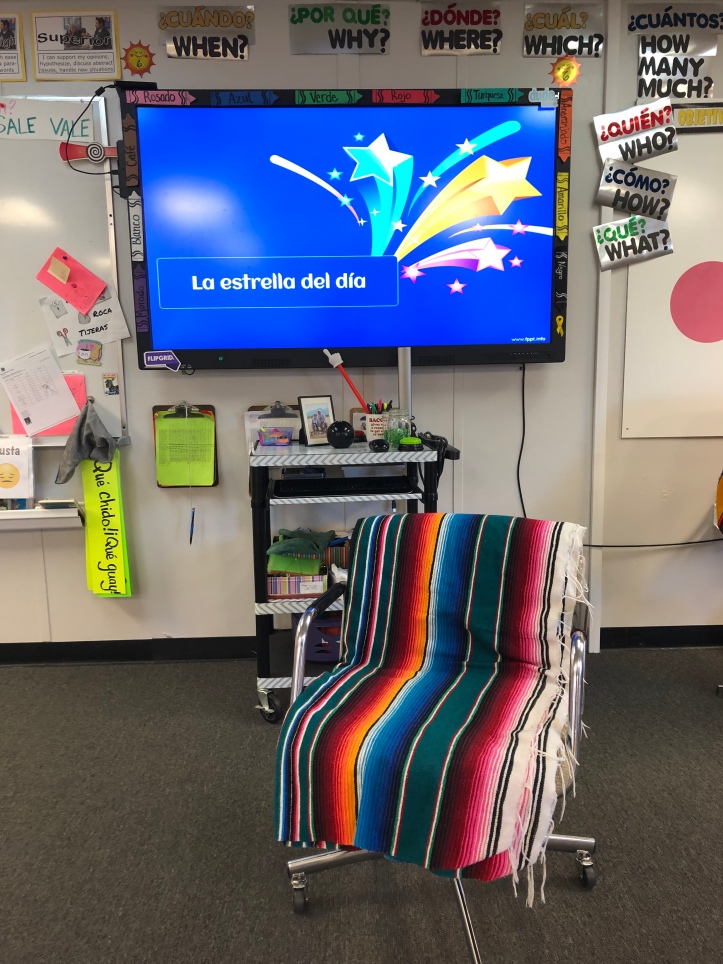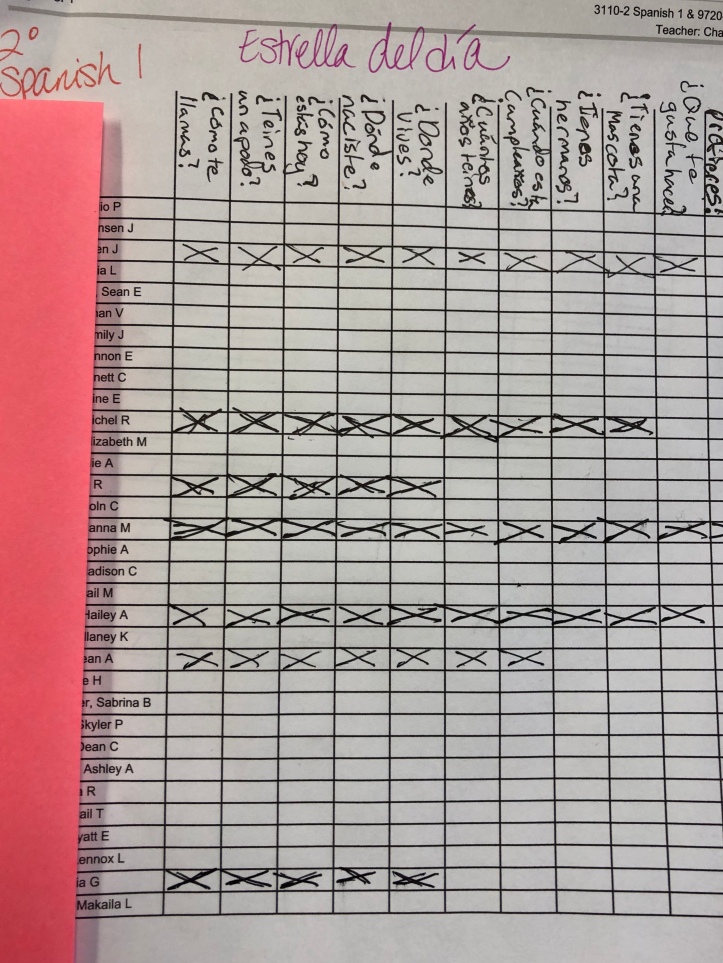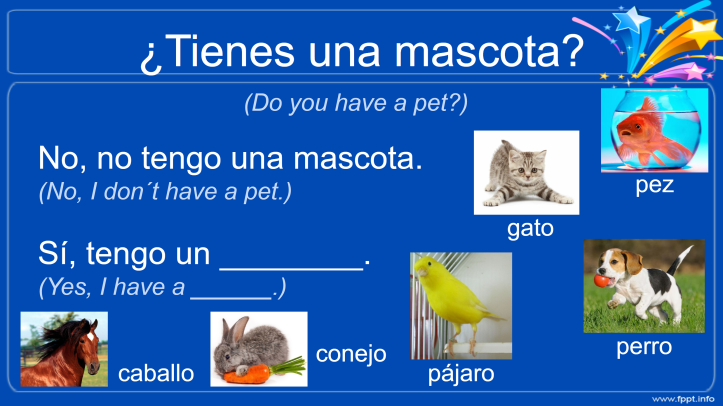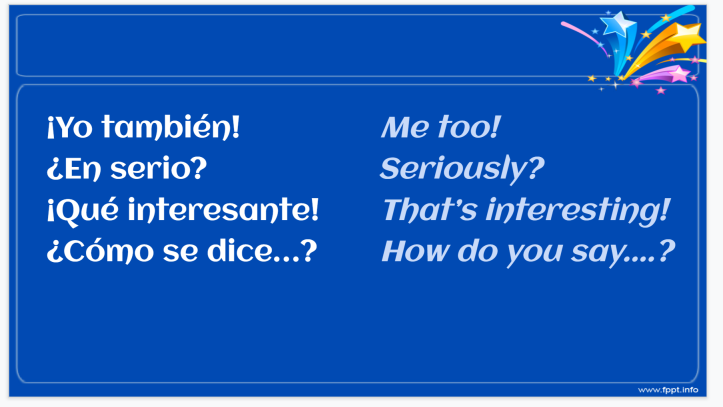Star of the Day, AKA Special Person Interviews are awesome. If you’ve not implemented them yet, don’t wait another minute! And if you’re already rocking and rolling with them, I’ve got a few tricks to make them even awesomer!
But first, a tiny bit of background:
Special Person Interviews are Bryce Hedstrom‘s brain child and he first introduced the CI world to them. He’s written a lot about them on his website:
- Wondering how to get started?
- Looking for some (FREE) Special Person resources in about a zillion languages?
- Wanting to read more about the steps of the process?
While this was Bryce’s idea, it was Michele Whaley’s NTPRS session in Reno a few years ago who convinced me that “Star of the Day” would engage my students. Her explanation helped me visualize it in my classroom. I just love gleaning wisdom from Michele and I thought, if she says it’s THAT awesome, I better try it out! I’ve adopted Michele’s name, because I’m all about teaching my kiddos new words and my kiddos didn’t know estrella so I decided to go with that. But no matter what you call it, you’re going to love it!
Enough chit chat…what is Estrella del día?
Basically it’s doing what we do: giving our students lots of slow and rich language they understand while at the same time highlighting a particular student, The Star of the Day. The great thing is the repetition of 2nd person questions and 1st person answers, which they are exposed to all year long.
And it still surprises me how much they love it! They frequently ask if we’re doing Estrella del día and when I give them the choice between playing a game and doing Estrella del día, they almost always pick Estrella del día, which is fine by me because it’s one of those Zero-Prep-High-Mileage activities that loads them up with Comprehensible Input and takes very little effort on my part. Win-win-win-win!
The powerpoint I use is a collaboration between my dear friend Rita Barrett and myself and she gave me the green light to share it with you fine folks! You can thank her by dropping by her Teachers Pay Teacher’s store, Siempre Positivo or by adding her novela Libertad to your Free Reading library!
Spanish 1 Estrella del Día Slide Show
Chinese Star of the Day Slide Show, thanks to Yu-Ming Cheng
French L’étoile du jour Merci, Audrey Misiano
If you’re feeling generous, and would like to translate it into the language you teach, I’d love to share it here! Hit me up!
How we do Estrella del día:
- I have a special chair that I just happened to find in an empty storage room that just happens to swivel that just happens to be perfect for Estrella del día! It’s nice and comfy and spins around to face the board then spins back to answer the question, towards the class. It’s on wheels so it’s easy to push front and center for our Star of the Day. You probably could do Star of the Day without a special chair…but I’m not positive.

2. Back in August, I assigned a “Secretaria de la Estella del día” who is in charge of keeping track of who we’ve interviewed and the questions we’ve asked. I printed out a spreadsheet with students’ names on the left and a bunch of blank columns and put it on a clipboard hanging at the front of the room. During our Estrella del día interviews, my secretary grabs the clipboard, writes the questions across the top (as we ask them), and gives students check marks as we ask them those questions. At the conclusion of the interview, the secretary awards our star with a star sticker, of course!

3. The slideshow has about 20 questions… we don’t start with 20 questions from the get go! The first time we interview, I’ll only has the first 3 or 4 questions, which are super basic…What’s your name? How are you feeling? Where do you live? What’s your social security number and credit card information? (JK!). Then after a few interviews with those, I’ll add in the 5th question. Then a few days later add into the 6th question. As the questions progress they get more complicated. We slowly add in questions to maintain students’ interest…which is why the Secretaria has a critical role. The students who are interviewed at the very beginning of the year are asked fewer questions, so we’ll go back to them at the end of the year to re-interview them.
4. No one HAS to be the Star of the Day! It’s totally optional, because it’s not really about outputting the answers but more about giving everyone else lots of repetitive input. I ask for volunteers OR use my Magic Cards to randomly select a student and ask if they would like to be the Star of the Day. They are allowed decline. We’re all about keeping their affective filters low and the input high around here.
5. Estrella del día isn’t supposed to be stressful! It’s not a speaking assessment. It’s not to see how much they’ve acquired. It’s a vehicle to deliver more input to the class. The slides have the questions and answers written in Spanish and English. The English is there to make the kiddos feel comfortable, a safety net of sorts. And it allows us to start Star of the Day at the very beginning of Spanish 1. You don’t have to pre-teach any vocabulary. I repeat, this isn’t supposed to be stressful!! (For YOU or THEM!)

6. We don’t do Estrella del día every day, but you could. I have it on my lesson plan as the last activity almost every clas, and someday we get to it and some days we don’t. Some times we have time to do 2 Stars of the day. I love it that I always have it ready to go, if I need a filler. Just know…there are no hard and fast rules. Do what works for you!
And how do you make Estrella del día awesomer?
- My biggest concern, when I first heard about Special Person Interviews, was keeping everyone else engaged. Then I cracked the code and this has become a beloved class tradition. I teach a few expressions, right before we start our interview, that students are encouraged to holler out during the interviews. Since it’s on the second slide, we review them every time we do a new interview.

While I’m interviewing, our star is answering and the students are listening carefully. Whenever the Star says something that applies to students, they shoot their hand up and exclaim “¡YO TAMBIÉN!”. So for example, our Star tells us that her name is Hailey. The Other Haley in the class raises her hand and says “¡YO TAMBIÉN!” and then Star of the Day Hailey jumps up and gives The Other Haley a high five and they both say “Chócala”. Our Star of the Day says he’s tired, and everyone who’s also tired yells out “¡YO TAMBIÉN!”, and he runs around the room high fiving everyone who’s hand is raised. Our Star of the Day was born in Nevada. ¡Qué casualidad! Most of the class belts out “¡YO TAMBIÉN!” and the Star makes the high five rounds. Since I’m all about input, all the time, while the star is high fiving, I’m narrating: Joe también tiene dos perros. Y Will tiene dos perros, y ¿Cody, tienes dos perros también? The high fiving goes fast and it’s a little bit chaotic but it makes it really fun, and I love it drawing students’ attention to their similarities and making connections within my class. (If we have a low energy Star of the Day, I’ll allow Long Distance High Fives, where she stays in the special chair and does the motion with everyone’s raised hand….you don’t want to force a kid to get up and high five everyone because they’ll move at a snail’s pace and it will be painful for all.) But seriously guy, the ¡YO TAMBIÉN! addition makes it so much fun! ¡Chócala!
2. Change up how the questions are asked. At the beginning of the year, I ask the questions to our Star of the Day. The student answers, then I summarize the information back to the class. It sounds like this:
Señora Chase: ¿Cómo te llamas? (As I am pointing and pausing at the words, giving the Star time to read the translation below it).
Student: Colin
Señora Chase: Hola Colin. Chicos, este muchacho se llama Colin. Por favor, digan -¡Hola, Colin!-
Class: Hola Colin.
(Flip to next slide)
Señora Chase: Colin, ¿Tienes un apodo? (Pointing and pausing on the translations)
Student: No
Señora Chase: Colin, ¿quieres un apodo? (gesturing quiere, pointing to apodo’s translation)
And so on…The important thing is to listen to the kid. Ask follow up questions. Report the information back to the class. And keep it moving so no one gets bored.
After a couple of weeks, I will signal with my fingers 1, 2, 3 and when I point at the class they will ask the question o the slide in unison, then the student answers, then I recap the information and ask follow up questions. Once they get over that, further in the year, I’ll ask for a student interviewer. That’s fun for a couple weeks, but then we need to spice it up a bit. That’s when I bring out the microphone. It is so fun to have students do the interviews with a microphone like a news reporter! I found an old garage band microphone at a thrift store, and it is one of my most beloved props. It’s not even plugged into anything but it’s just so much fun!
The important thing is to change it up so kids don’t bored with Estrella del Día.
3. Star of the Day interviews are not only for students! One year my mom came into class and we interviewed her. Today our security guard dropped by and graciously allowed us to interview her. Next week my principal is scheduled to come by for an interview which will certainly be hilarious because he’s a funny guy AND he has the best worst Spanish accent of all!
And that’s how we do Estrella del Día in my class! I’d love to hear the tricks you use to spice it up in your classes!


OMG. I’m going to institute Chócala and También right away. I just started doing Star of the Day in my elementary classes with the slide shows — hadn’t used one before, in favor of having kids draw their families on the board and talking about them, or asking everyone one question and putting the answers on a chart or having them draw their answers on a mini white board. They knew their talk needn’t be completely truthful, so we had one family with many pets and multiple grandparents instead of parents, for example. I like this a lot though, and now that I’ve initiated the slide-show talks, I will have even more class participation! I hope I may share these ideas for an upcoming talk at our state conference…will credit you as always…
LikeLike
Oh my goodness…elementary is a whole other ballgame!! Yes, of course you can share chócala and también at your conference!! Hope you’re having a great year, my friend!!
LikeLiked by 1 person
Thank you so much for sharing. I changed the language in Chinese and made a little changes. https://docs.google.com/presentation/d/1qtcXQ-l_PO-QtwXUUyQXi0j5j05fK6o5O4Yb6NgHfpQ/edit?usp=sharing
LikeLike
This is so awesome!! Thank you for sharing your translation, I’ve linked it above for other Chinese teachers! I’ve also got Chinese translations for The Lucky Reading Game and 20 questions- feel free to pass those along to the Chinese teachers you know!!
LikeLike
[…] different colored paper. (So the Día de los muertos story was printed on yellow, and Sean’s Estrella del Día Biography was copied on pink and the Rock, Paper, Scissors story was copied on green and Buster the […]
LikeLike
Thank you so much! I changed the language to French: https://docs.google.com/presentation/d/1KLIdFXOwmUbX1CrYKBaNH7GRgFBKH68OPSdOq3LACaE/edit?usp=sharing
This is going to be epic and I cannot wait!!!!
LikeLike
Merci!! Thanks so much for translating it to share!
LikeLike
Thank you so much for sharing. I have been looking for this for a while. You are awesome.
LikeLike
You’re welcome!
LikeLike
Thank you so much for all of your resources and knowledge, I am learning so much about Comprehensible Input on your website! I am totally going to implement la Estrella del día.
LikeLike
We’re starting Estrella next class! I’m excited!
LikeLike
[…] we’ve done consistently this year is Estrella del Día Interviews followed by a little Write and Discuss action. For the reading portion of their final, I took 4 of […]
LikeLike
I am getting even more mileage from Star of the Day by having students create notes together after the interview ends (like Write and Discuss). I have a form for scaffolded notes to help them compare themselves with the star student. The think of what they have in common, what is different and what more they would like to know about the student. The form is available for free in my TPT store. https://www.teacherspayteachers.com/Product/Estrella-del-dia-apuntes-7734387
LikeLike
Thanks for sharing, amiga! I’ll check it out!
LikeLike
Any chance you have a similar resource for second year Spanish or can recommend one? Thanks!
LikeLike
I did Star of the Day last year and it was so successful. It really primed my Ger 1 kids to be able to give basic information at the end of the year. I have some “reluctant learners” and so I always gave a T/F quiz at the end. I’d have prepped on the computer a quiz with TFFFT, for example and then I made sure my first statement about the kid was true and my second was false etc. (Think I got that idea from you too…)
One tip I have is that I save the note sheet I write as I’m interviewing each kid. Later in the year I did a “Guess who” activity, giving info from the sheet and kids had to guess. They were baffled how I remembered all the info and surprised that I had saved the sheets.
Thanks as always for so many good ideas.
LikeLike
I love it! So smart to keep notes from star of the day! I love it!!
LikeLike